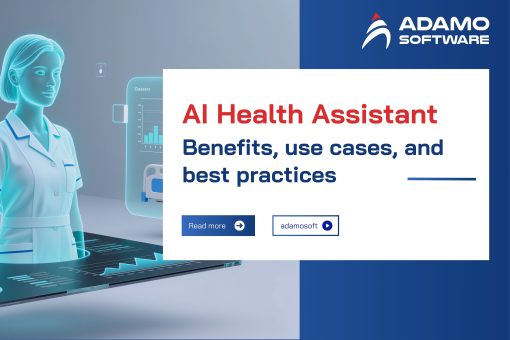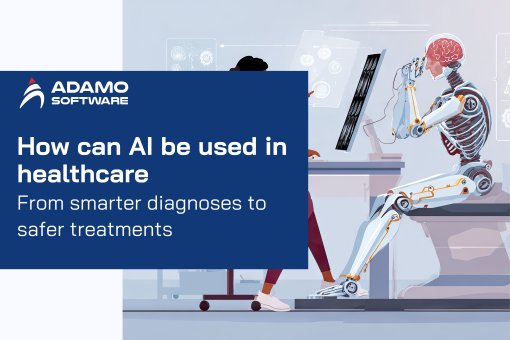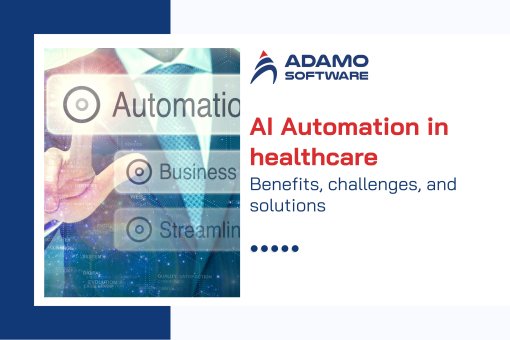Electronic Healthcare Records Pros and Cons You Need to Know

With the current advancements in technology and the growing complexity of healthcare systems across the globe, EHR has emerged as a significant strategy to address patients’ care needs in modern society. This understanding is crucial for improving healthcare systems’ effectiveness and patient satisfaction. EHR systems offer benefits like better and easier accessibility of data. They also have a low work cycle. However, they have disadvantages such as the expensive cost of implementation and privacy issues.
Below is a detailed understanding of electronic healthcare records pros and cons. This will assist any healthcare facility in making a suitable decision for practices. Analyzing the advantages and issues encountered in applying EHRs helps healthcare providers synchronize with the challenges. This allows them to use technology to provide the best patient care.
I. Understanding Electronic Health Record (EHR)
Electronic health records are a digital and upgraded version of patients’ paper-based charts. EHRs are precise, operative, patient-specific records. They hold details that can be accessed immediately and safely by all authorized persons. Traditionally, paper-based records have been used for many years.
1. What is an EHR?
An EHR includes an entire patient’s health history. This includes diagnoses, treatments, prescriptions, immunizations, allergies, and other details such as X-rays and lab results. The digital record enhances the effectiveness of healthcare delivery. It offers timely, accurate, and comprehensive information on patients’ health status during care delivery.
2. History and Evolution
The use of EHR can be traced back to the 1960s. Dr. Lawrence Weed introduced the idea of a problem-oriented medical record. This idea paved the way for modern EHR systems. The implementation of EHRs increased towards the end of the 2000s. This was due to improvements in information technology and the need for better quality and efficiency in healthcare provision.
3. Benefits of EHRs
Among the advantages are better patient treatment and patient engagement. EHRs also lead to better diagnostics and results, better cooperation between specialists, and optimization of practice. They lower the rate of contradictory medical reports. They enhance the comprehensibility of complications in the reports.
4. Development of EHR Systems
The development life cycle of an EHR system has several phases. These include needs assessment, system design, software development, testing, and implementation. Every phase plays an important role in achieving the desired system requirements. This involves various stakeholders of the health facility and the regulatory measures in place.
Understanding electronic healthcare records pros and cons is crucial. Knowledge of EHR’s subtleties is important. Implementing EHR systems is a best practice that has boosted the transition toward modern healthcare. It has improved the quality of healthcare results. Understanding the past, parts, and advantages of EHR prepares one to handle the electronic healthcare records pros and cons.
II. Pros of Electronic Health Record
Electronic health records have numerous benefits. It increases the efficiency of the healthcare system in several ways. Here are the key benefits:
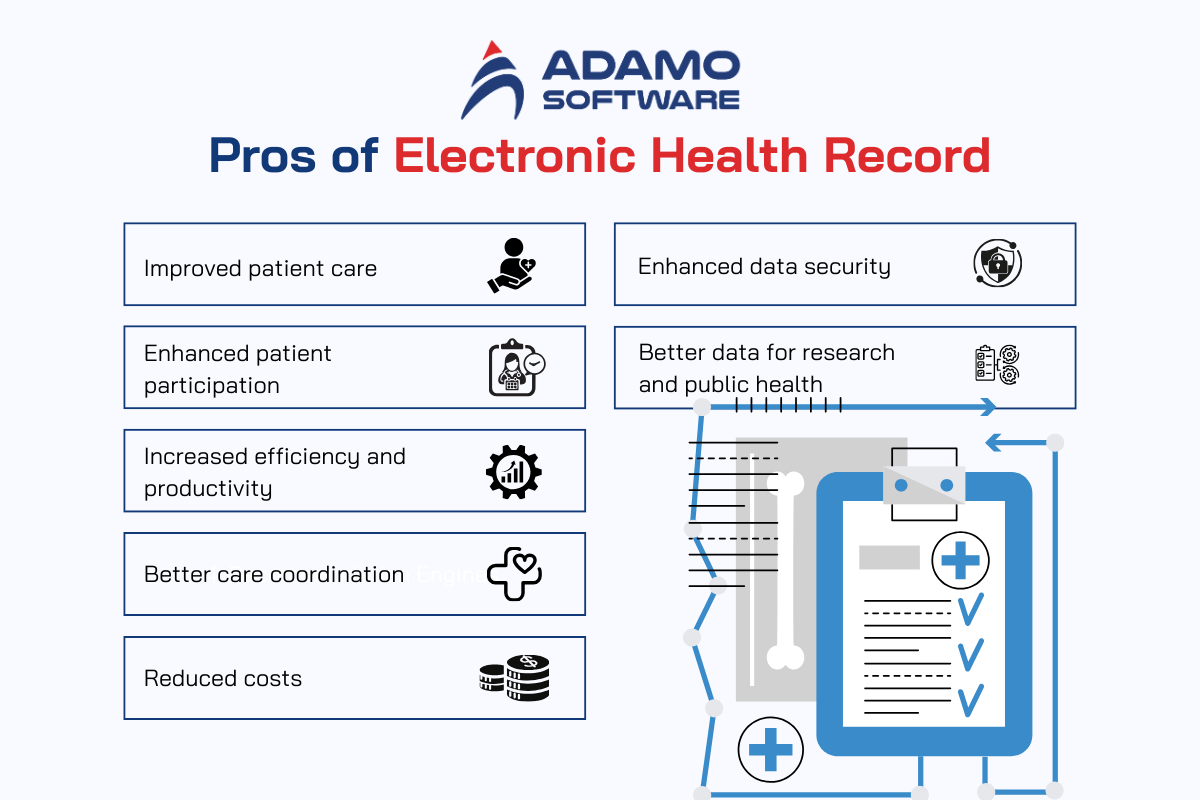
1. Improved Patient Care
EHRs grant the client’s records access within a short time. Therefore, caregivers will attend to the patient with sufficient knowledge about them. This results in the improvement of decisions and accurate identification. It also improves the handling of diseases and illnesses. The information helps doctors avoid mistakes and helps them understand the patient’s history.
2. Enhanced Patient Participation
This paper also identifies how patients can be directly involved in their care through EHRs. Most systems enable clients and customers to review personal health information. They also allow customers to make appointments and have virtual conversations with the professionals who attend to them. This promotes the patients’ and providers’ interaction and makes the patient more involved in his or her treatment process.
3. Increased Efficiency and Productivity
EHRs lead to a reduction in the time of carrying out administrative tasks such as managing patient records. Automated processes for prescription orders, billing, and appointments help to save time. Hence, it allows clinicians to attend to other patients, increasing patient attendance. This efficiency can reduce the waiting time and increase patient satisfaction.
4. Better Care Coordination
They enable efficient translations of a patient’s record across one or more providers and multiple systems. This is especially relevant for patient care if the person visits several specialists. It is also helpful when a patient needs an integrated approach when receiving services from different healthcare facilities. EHR enables all providers to have equal access and avoids a repeat of a test or procedure done by another provider.
5. Reduced Costs
Essentials of EHRs can provide quantifiable healthcare costs. Hence the urge to adopt EHRs can boost cost savings. By cutting paperwork, decreasing redundancy of tests, and increasing work efficiency, healthcare providers can decrease operational expenses. Further, as it has been indicated, EHRs can reduce the likelihood of errors. They can reduce the expensive affair of repairing. Hence, EHRs help to achieve the best financial returns on any investments accorded to healthcare organizations.
6. Enhanced Data Security
Compared to paperwork, EHRs provide enhanced security for the patient’s data. Complete data security includes enhanced techniques in encryption and controlling access to the data. This enhanced security is crucial in keeping patient trust as well as addressing compliance-related issues.
7. Better Data for Research and Public Health
Electronic healthcare records were removed from their free structure. They indicated that EHRs contain useful data that can be used in medical research and public health. The non-disclosed data of EHRs can be used in risk analysis, treatment algorithms refining, and policy recommendations in public health. Such an approach can help enhance the current medical database and the overall population’s health status.
Simply put, depending on the electronic healthcare records pros and cons, proper steps have to be taken in adopting EHRs. The advantages of EHRs indicate the overall positive impact on the healthcare sector. Understanding the electronic healthcare records pros and cons ensures healthcare stakeholders make informed decisions. This optimizes patients’ health status and efficiency in healthcare delivery systems.
You can explore more about What is EMR in Healthcare: Types, Features, Cost here.
III. Cons of Electronic Health Record
While electronic health records (EHR) offer many benefits, there are also notable challenges and drawbacks associated with their use. Here are the key disadvantages:
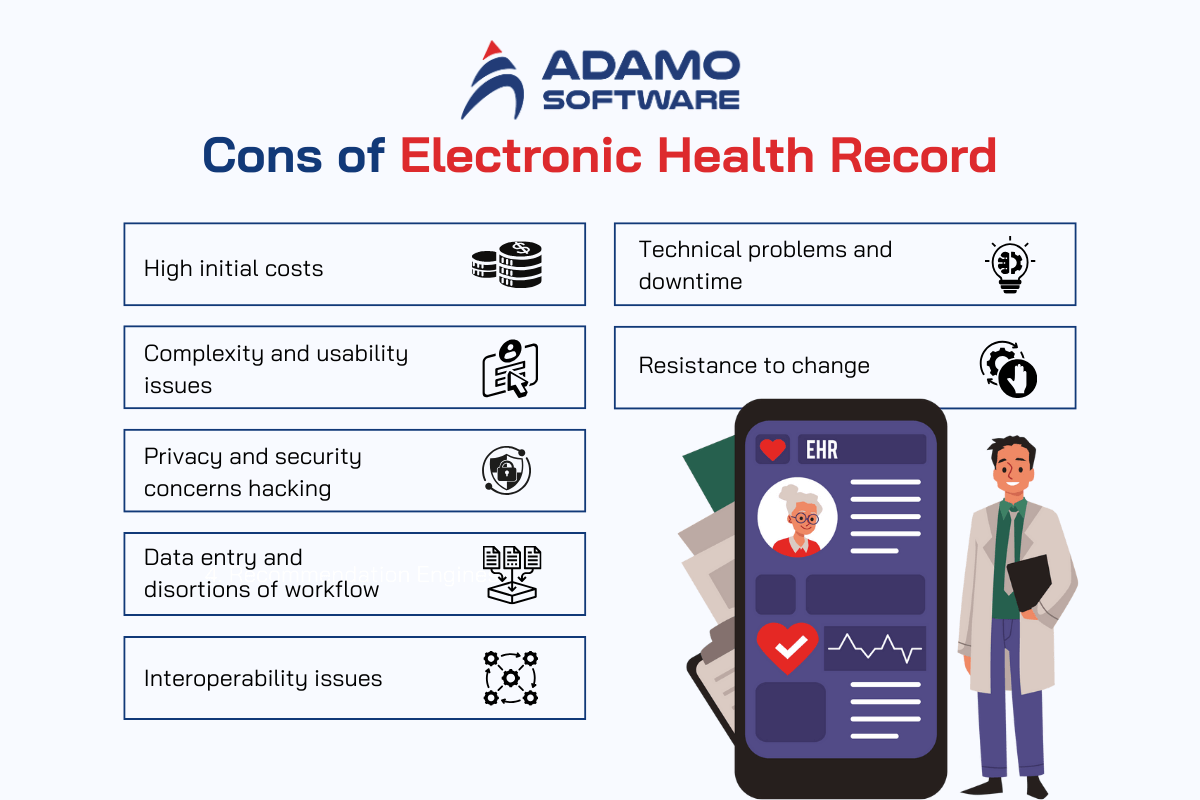
1. High Initial Costs
The adoption of EHR means huge investment costs are incurred in terms of hardware, software, and employee training costs. Some of these initial investments cost money and could be a burden to small practices in healthcare settings. Some of these high costs need to be considered to understand the electronic healthcare records pros and cons.
2. Complexity and Usability Issues
EHR systems are often huge and challenging to master and use. It’s especially challenging for healthcare personnel not used to computers and digital devices. It can be steep for most employees, resulting in frustration and mistakes when proper training is not offered. Problems related to the usability of the EHR systems can affect the effectiveness and level of healthcare staff satisfaction. This is another argument regarding the electronic healthcare records pros and cons.
3. Privacy and Security Concerns Hacking
EHR systems contribute to improving data security, but they also create new issues related to privacy and security. External risks include virtual offenses that pertain to cyber threats like data breaches and hacking, among others. Confidentiality of the patient’s information is paramount. It entails implementing several security features that may be expensive and complicated. When discussing the electronic healthcare records pros and cons, these privacy problems must be solved.
4. Data entry and distortions of workflow
Denning paper-based records and adopting EHRs may interfere with reliable and usual routines. Healthcare providers sometimes spend a lot of their time entering data. This takes a lot of their time away from the patients. It also results in a raised administrative burden that may cause job dissatisfaction and ultimately giver’s burnout. These disruptions are contemplated reasonably when deciding about the electronic healthcare records pros and cons.
5. Interoperability Issues
Although significant strategies have been made towards the certification of the interoperability of EHR systems, it has not been achieved. Multiple EHR systems may not interface with one another, resulting in discontinuous patient data. As many as several benefits can be expected when it comes to electronic healthcare record systems. This lack of fluidity regarding the data flow between different healthcare facilities can hinder effective healthcare delivery. Therefore, it impedes the improvement of the quality of care provided to patients.
6. Technical Problems and Downtime
The maturity of EHR systems brings issues inherent with any complicated software. They can be EHR software glitches, system crashes, and, in some cases, even downtimes. These problems at the facility level can cause interruption of healthcare services and late control of patients’ conditions. This brings up the other aspect of the debate on electronic healthcare records pros and cons, namely, dependable technical support and maintenance to avoid these disruptions.
7. Resistance to Change
The implementation of an EHR system meets organizational resistance. This resistance comes especially from healthcare providers used to traditional paper-based record-keeping. This resistance can hamper the flow and pace of the implementation process. It also affects the general performance of the EHR system. It is important to discuss the electronic healthcare record advantages and disadvantages of this resistance.
Electronic healthcare records advantages and disadvantages can be discussed using the Henderson model. This model reveals key factors such as high initial costs, complexity and usability, privacy and security, data entry and workflow, data sharing, technical issues, and organizational resistance. These cons help healthcare providers make adequate decisions concerning EHR adoption.
IV. Development Process of the EHR System
Creating an EHR system is complex and consists of several stages. Every stage is significant to guarantee that the final system complies with the requirements of healthcare providers and meets all legal needs. Here is a detailed overview of the EHR development process:
1. Needs Assessment
The first activity in the implementation of EHR is the needs assessment. This involves knowing the exact specifications of the healthcare organization. It includes understanding the workflow navigation procedures in that organization. It also involves understanding the data handling demands and the users’ choices. Other stakeholders from various departments are essential. They assist in identifying what should be included in the EHR system and what functions are crucial. Understanding the electronic healthcare records pros and cons during this phase ensures the system will handle both the advantages and the disadvantages.
2. System Design
The last process that has to be implemented is the system design. This comes after the needs assessment is done. This involves designing the EHR system. It comprises the basic structure, how data is processed, and the electronic appearance of the medical records system. The design phase combines ease of use with technical and functional specifications earlier defined. This phase also focuses on electronic healthcare records pros and cons to coordinate aspects and make them functional.
3. Software Development
This phase covers the specific coding and development of the EHR system as per the laid-down design. This phase involves software developers, healthcare practitioners, and IT specialists. Security, scalability, and efficiency in terms of system execution are the main priorities. Before implementing and promoting the system, the development team should weigh the advantages and disadvantages of EHRs to eliminate possible problems.
4. Testing
Testing is crucial to find out the problems that the system may contain. It helps solve these problems before the launch. These include unit, integration, and user acceptance testing. Testing confirms that the implemented EHR system works as planned. It is useful for physicians and other health workers. Dealing with the electronic healthcare records pros and cons during testing assists in fine-tuning the system. It increases its efficacy.
5. Implementation
In this process, the organization needs to acquire the EHR system. They must install the software. They need to set up the system. They must transfer data from the previous system into the EHR system. Education and communication of the new system to different healthcare providers and employees are also important. Implementation poses a challenge since it must be done in a way that interrupts health services as little as possible. Awareness of electronic healthcare records pros and cons aids in a shift to such records.
6. Maintenance and Support
Maintenance and support of the implemented EHR system are critical to guarantee its future sustenance. This entails periodic updates, problem-solving, and responding to user input. Constant evaluation makes it easier to find the appropriate changes to make. It keeps the system relevant for the changing health sector. End-user perspectives on working with a particular EHR system also define its maintenance. Thus, it’s important to remember the pros and cons illustrated above.
The transformation of an EHR system is a sequential process divided into various phases. Each phase is crucial to the success of the EHR system. Evaluating EHR’s strengths and weak points indicates that healthcare professionals can choose the right electronic medical record system. This yields positive results. It focuses on patients and hospital or clinic requirements. It also corresponds to legal specifications.
V. Adamo as Your Reliable EHR System Provider
Selecting the appropriate EHR system provider is one of the most vital factors before using an Electronic Health Record (EHR) system. Adamo Software is a trustworthy partner in this sphere. We provide integrated solutions suitable for healthcare organizations. Here are the reasons why Adamo Software is the ideal choice for your EHR system:

1. Expertise and Experience
Adamo Software is a premier healthcare software development company. Our team of experts knows how healthcare organizations work. We know what rules we must obey to be compliant. That is why our developed EHR systems will be workable. and complain. With this expertise, Adamo can meet the electronic healthcare records pros and cons. We improve efficiency and patient care.
2. Customized Solutions
Adamo Software designs and develops unique EHR systems. We address each client organization’s requirements. Our solutions are built in cooperation with clients. They can be efficiently incorporated into existing systems. Adamo not only promotes electronic healthcare records. We provide solutions where the strengths outweigh the weaknesses.
3. Proven Track Record
On Adamo Software’s website, you can see our capabilities. We have examples of effective projects in healthcare. Our past performance in implementing efficient EHR systems ensures we meet client expectations. We provide effective solutions. This success history indicates our desire to balance the electronic healthcare records pros and cons.
4. Dedicated Support
Adamo Software provides constant assistance for EHR system integration. We offer regular updates of systems. Our support team is always available to address issues. We train the organization’s healthcare providers. We offer support on how to leverage their EHR systems. This commitment to support assists in reducing the electronic healthcare records pros and cons. We carefully address potential issues without delay.
5. Innovative Approach
Innovation is a high priority for Adamo Software. We develop cutting-edge solutions. We follow advancements in the IT field. This proactive approach ensures our EHR systems are always up to date. We grant healthcare providers the tools to deliver quality services. Adamo comprehensively controls the advantages and disadvantages of electronic healthcare records. Our systems are more complete, advanced, efficient, and user-friendly.
When considering the EHR pros and cons, it is vital to involve a provider who ensures the most gains and minimizes the drawbacks. By specializing in healthcare information technologies, providing dedicated solutions, having a record of successful implementations, offering exceptional support, and introducing new ideas, Adamo Software is a trusted partner healthcare organizations should consider for implementing an EHR system.







